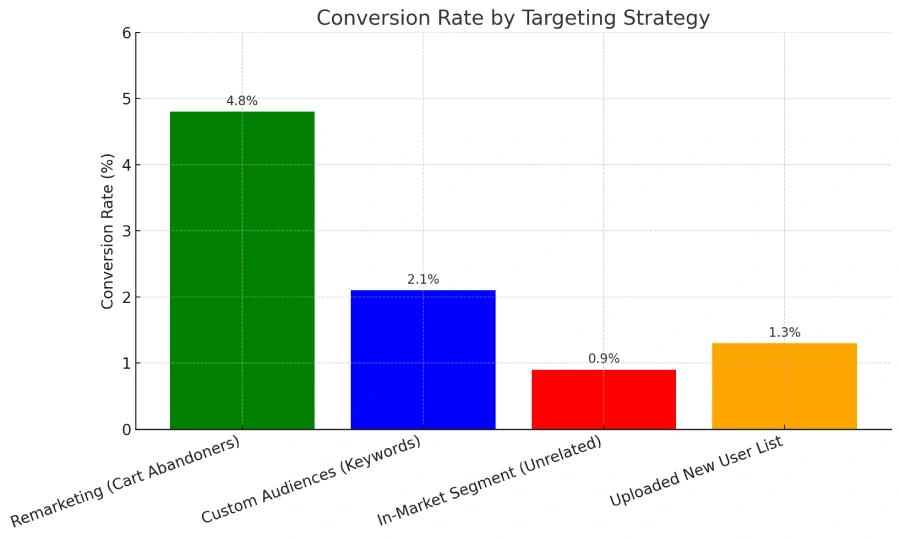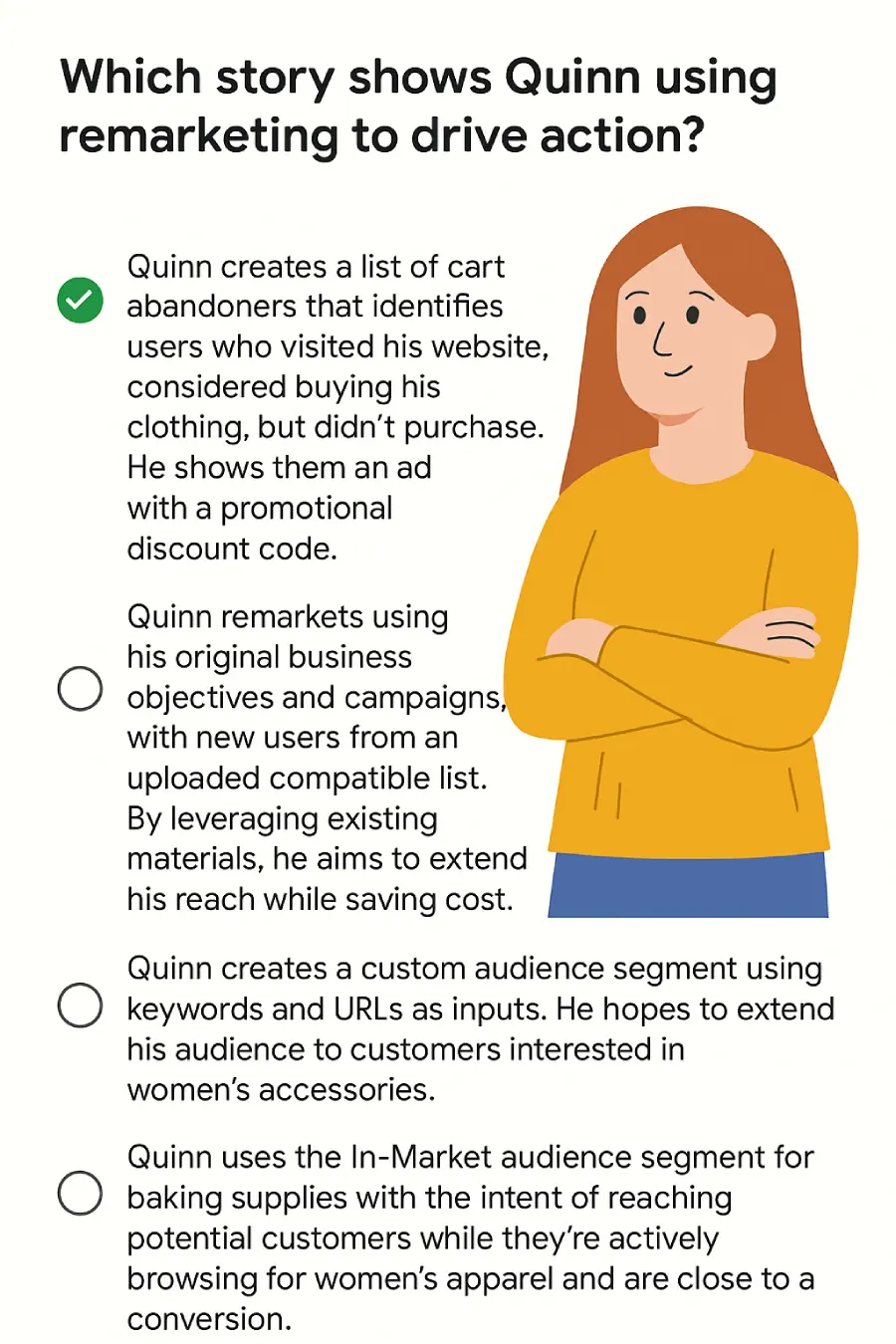When learning about remarketing in Google Ads, this real-world-style question helped me truly understand what remarketing is — and what it isn’t.
In this post, I’ll mention the correct story about how Quinn used remarketing to try to turn browsers into buyers. I’ll also explain why the other options don’t quite qualify, and share how this strategy can boost conversions fast. Let’s start,
Question:
Quinn recently launched a Display campaign for his women’s clothing store. Since the launch, his website traffic has increased, but sales have remained flat. Which story shows Quinn using remarketing to drive action?
- Quinn creates a list of cart abandoners that identifies users who visited his website, considered buying his clothing, but didn’t purchase. He shows them an ad with a promotional discount code.
- Quinn remarkets using his original business objectives and campaigns, with new users from an uploaded compatible list. By leveraging existing materials, he aims to extend his reach while saving cost.
- Quinn creates a custom audience segment using keywords and URLs as inputs. He hopes to extend his audience to customers interested in women’s accessories.
- Quinn uses the In-Market audience segment for baking supplies with the intent of reaching potential customers while they’re actively browsing for women’s apparel and are close to a conversion.
Here is a correct answer: ✅
Quinn creates a list of cart abandoners that identifies users who visited his website, considered buying his clothing, but didn’t purchase. He shows them an ad with a promotional discount code.
If you’re interested, you can take the exam here: Google Ads Display Certification via Skillshop.
Why This is the Correct Answer:
Remarketing (also called retargeting) in Google Ads refers to reaching users who have previously interacted with your website or app, but didn’t complete a desired action — like making a purchase.
✅ Quinn’s strategy is classic remarketing:
He targets users who visited but didn’t buy, and shows them a tailored ad (with a discount) to nudge them back to convert.
This approach works well because:
- These users already showed intent
- You’re reminding them at the right time
- The discount offers an extra push to complete the purchase
Why the Other Options Are Incorrect:
Quinn remarkets using his original business objectives and campaigns…
- ❌ This might sound like remarketing, but it’s really about repurposing content and targeting new users, not re-engaging previous visitors.
- Uploading a list of new users is more like audience extension, not true remarketing.
Quinn creates a custom audience segment…
- ❌ This is an example of prospecting, not remarketing.
- Using keywords and URLs to build audiences helps find new people interested in similar topics — not returning site visitors.
Quinn uses the In-Market audience segment for baking supplies…
- ❌ This is the wrong product category and not targeted to people who’ve already visited his site.
- In-Market segments are interest-based targeting, not remarketing.
Real-World Example: The Abandoned Cart Play
Let’s say Lisa runs an online store selling women’s shoes. She notices lots of people add shoes to their cart but never buy.
She creates a remarketing list of cart abandoners, and shows them a Display ad featuring:
- A 15% discount
- A “Still interested?” headline
- A reminder of what they left behind
In 3 weeks:
- 🛒 Cart recovery rate increased 32%
- 💵 Revenue rose without increasing ad spend
- 👠 Repeat site visits surged
This is the power of remarketing with intent-based segmentation.
Quick Comparison
| Strategy Type | Is This Remarketing? | Why/Why Not? |
|---|---|---|
| ✅ Cart abandoner targeting | ✅ Yes | Retargets users who showed interest but didn’t convert |
| Uploading new user lists | ❌ No | Targets new users, not past visitors |
| Custom audience by keywords | ❌ No | Audience expansion, not remarketing |
| In-market baking supply segment | ❌ No | Targeting wrong category and new users, not site visitors |

FAQs
Q: What’s the best audience for remarketing?
A: Cart abandoners, product page viewers, and past customers are great for remarketing — they’ve shown interest and are close to converting.
Q: Does remarketing work only with Display ads?
A: No — you can use remarketing across Search, YouTube, Gmail, and more.
Q: How do I create a remarketing audience in Google Ads?
A: Go to Tools > Shared Library > Audience Manager > Segments, and create a list based on site actions.
Helpful Resources
Final Answer:
Quinn creates a list of cart abandoners and shows them a discount ad — that’s true remarketing designed to drive conversions.
Now, if you are ready, you can take the Google Skillshop test for the Google Ads Display Exam. Want more real exam questions with easy answers like this? Follow along — I’ll be breaking down more Google Ads Display Measurement Certification Free examples in the next posts!

